 |
 |
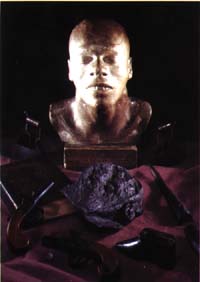 Relics of the Red Barn Murder. |
Local History Collections
The Local History Collection is an intriguing mixture of the humdrum and the bizarre, the mundane and the macabre; taken together it paints a picture of the people of Bury and West Suffolk over the last five centuries; at work and at play, in life and in death. Here we pick out just a few threads from this dense tapestry.
MEN OF THE CLOTH: A LEGACY OF WEALTH 1066 - 1539
The Medieval period saw West Suffolk at its wealthiest and most influential, with the abbey of St Edmund holding sway until its dissolution in 1539. Similarly, the widespread woollen industry brought great prosperity until it too lost its ascendancy in the 16th century. Much of the architectural legacy that gives West Suffolk its special character is due to these influences. Downstairs at Moyse's hall, the West Gallery holds a fine display of monastic relics from this period. Several examples of the Medieval wood carver's skills, when working for a wealthy patron, are on display. These include both architectural fragments and some furnishings of the period. Personal possessions, from shoe buckles to daggers, help throw light on the fashions and the fears that shaped everyday life.
CRIME AND PUNISHMENT
Moyse's Hall was, after all, once the town gaol. It still has barred windows here and there. It is not surprising, then, that local people have come forward with material relevant to such a theme. Items include a gibbet cage found at Honington; body irons; a cat-o'-nine-tails; stocks; a gaol door; and police truncheons. Gruesome relics of the celebrated 19th century 'Murder in the Red Barn' include the death mask of William Corder who was convicted of the brutal murder of Maria Marten in 1827.
Corder was hanged and his body dissected; a book about his trial bound in his own skin is on display, as is a section of his scalp, alongside some more conventional exhibits such as Corder's duelling pistols. Crime gripped the public imagination and these macabre relics are a testimony to a fascination with the murder that has been kept alive for over 150 years.
|
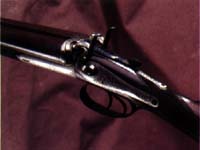 Double barrel shotgun by Scotcher. |
ARMS AND ARMOUR Like any country town, Bury St Edmunds was the centre of an important local gun trade and the museum has a large collection of guns mostly by local makers. The most notable of these was Scotcher whose shop was at 4a Traverse close to Moyse's Hall. One unusual exhibit is a cartridge display board dating from around 1912, containing 132 cartridges.
|
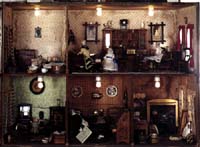 Dolls House, 1871. |
CHILDHOOD The surviving evidence of childhood from our past can be both funny and sad. One of the most popular exhibits in the museum is a dolls' house of 1871 made by George Harding of Weston-super-Mare for Edith and Annie Mason whose photographs can be seen hanging in the largest room. The house is beautifully furnished and decorated and includes some delicate handmade lace. There is also a collection of dolls, of which the most notable is a china-headed baby doll dressed by one of Queen Victoria's dressmakers, and a collection of teddy bears including one wearing a parachute harness! Another side of childhood is also depicted within the collections. A 16th century iron corset for a young girl must have been appallingly uncomfortable to wear, whether for support or punishment. Finally, and all too common in the past, the collections include a 19th century child's bier, used to carry the coffins of children to their funerals, in this case from Thorpe Morieux.
|
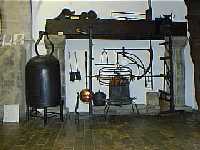 Collection of 18th-19th century cooking equipment. |
HEARTH AND HOME Much of the material acquired by the museum over the years is made up of everyday domestic items. Individually they are interesting; together they begin to paint a broader picture of life in the past with collections covering the whole spectrum of domestic life. Among the items of furniture are some interesting 17th century tables, and a bible box. Broadly contemporary are the tankards, stoneware bottles and the jugs called Bellarmines which were used for importing beer from Germany. All these were common in the alehouses of the 17th and 18th centuries. Beside an old fireplace brought from Hatter Street is an impressive array of cookery items including various spits, oven cauldron, bellows and other paraphernalia of hearthside cooking. From the 19th century, mass-production leads to a much wider range of items around the home; painted and transfer-decorated china, for example, would have been avidly collected by those who could have afforded it. A dazzling mixture of personal possessions - from tinder boxes to walking sticks - all offer clues to the fashions and foibles of domestic life in the past.
|
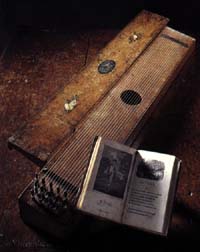 Aeolian Harp, made by Suffolk poet Robert Bloomfield, 1808. |
LOCAL GENIUS Suffolk has produced its fair share of creative thinkers over the centuries. Some went on to achieve fame and fortune, others lived out their lives locally, having perhaps enjoyed brief recognisition. Moyse's Hall Museum includes a few examples of what such people have left behind. Robert Bloomfield (1766 - 1823) was a Suffolk farm labourer who became a well-known poet but died in poverty (his most famous work is 'The Farmer's Boy'. He was something of a carpenter and made the table-chair and the exceptionally unusual Aeolian harp which are on display. Another local writer, Louise de la Ramee (1839-1908) better known as 'Ouida', author of many popular novels, was born in Bury St Edmunds. She too died in poverty but some of her last possessions were presented to the museum. The famous play Charley's Aunt by Brandon Thomas was first performed at Bury St Edmunds' Theatre Royal on 29th February 1892 - a tremendous coup for the local theatre; a range of memorabilia relating to the play are on display.
|
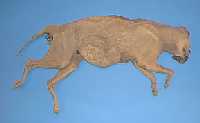 Desiccated cat, from Fakenham Magna. 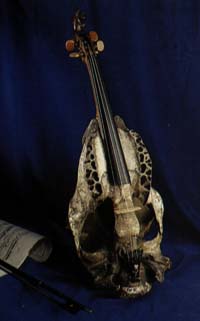 Horse-head fiddle, 19th century. |
THE WEIRD AND THE WONDERFUL It is often people's superstitions and fears as much as their enthusiasms and frustrations, which drive them to do things differently. Behind the veneer of everyday life, there is often a darker story waiting to be uncovered. The museum collections include some wonderful examples of the eccentric or the secret life of West Suffolk. Witchcraft has a long tradition in rural communities, and at Moyse's Hall Museum are a witches' puppet, witches' wands and witch bottles. The latter are Bellarmines filled with sharp objects, urine and perhaps human hair. They were buried within a house as protection, for it was supposed that any witch venturing near would be trapped in the bottle. Old houses undergoing restoration often are found to contain mummified cats and several from Fakenham Magna and Debenham are on display - again part of a tradition of placing good luck charms within the fabric of houses. Like other community museums, Moyse's hall has found a place for odd enthusiasms and strange ideas. There is the gigantic slab of coal (reputedly the largest individual lump then mined) used as a trader's sign. Also see the turtle shell that served as a shop sign in the town centre at Cupola House. What about a violin made from a horse's skull? (It sounds as bad as it looks.) Or should pride of place go to the model of a medieval church made entirely of snail shells?
|
| Go to Museums Homepage |
This page originally produced by Museum staff for the Council's website Updated 11 March 2002 | Go to Home Page |